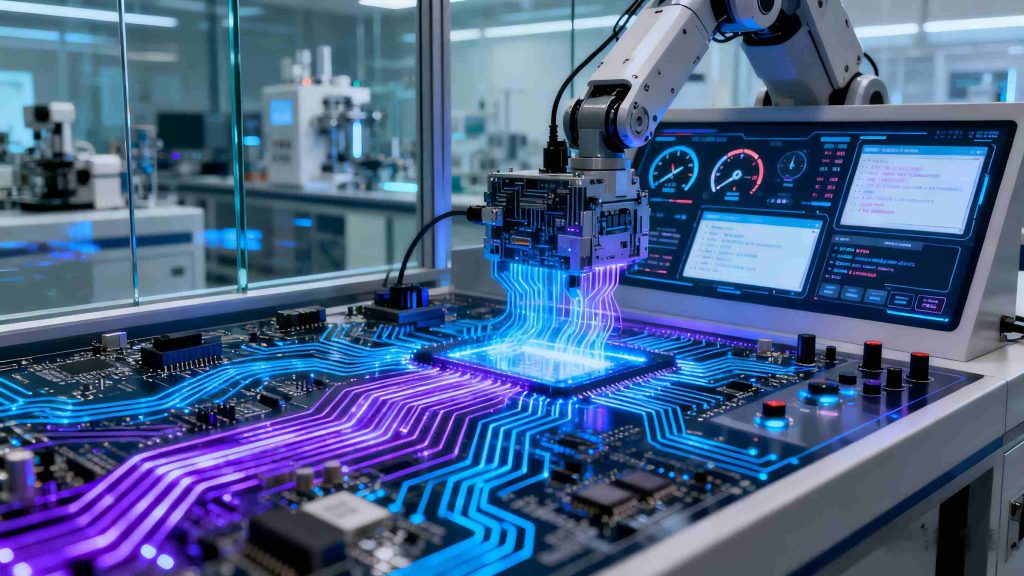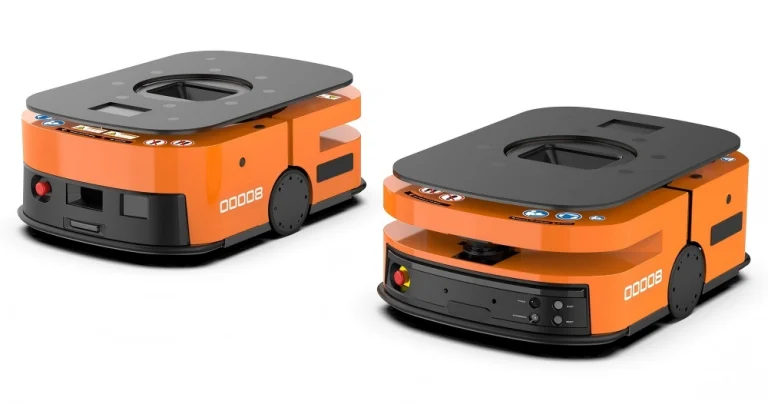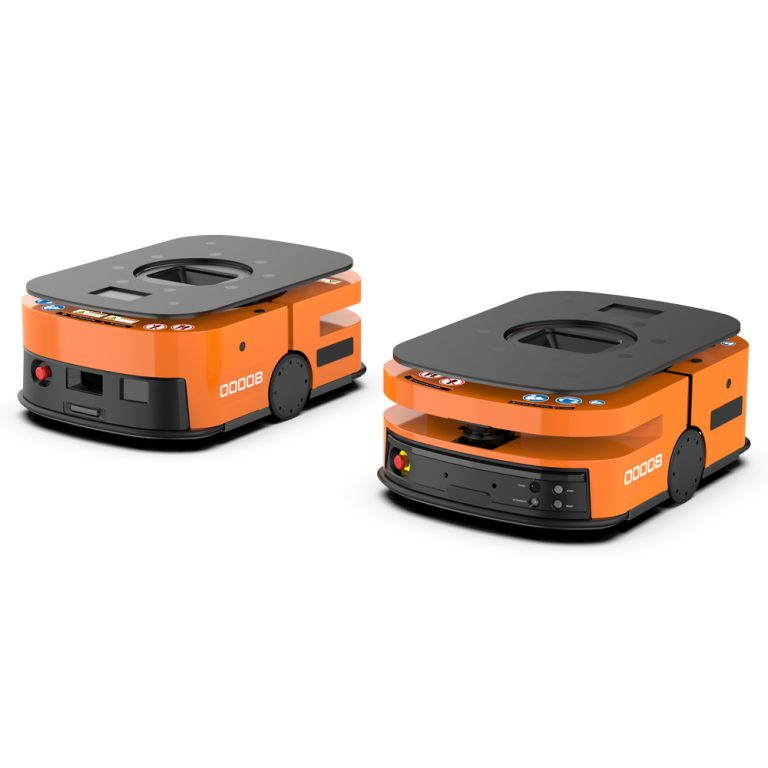
In the fast-paced world of automated warehouses and manufacturing floors, robots handle tasks that once required teams of workers. They navigate crowded aisles. They pick items from shelves. And they transport loads with precision. Yet, what sets high-performing systems apart? It’s the ability to process data right away. This turns raw sensor inputs into quick actions. It prevents bottlenecks. And it boosts overall efficiency. For those managing robot fleets, understanding real-time data processing can change operations from reactive to proactive. This post dives into how it works within robot control systems. It draws on practical insights to show its impact.
Understanding Real-Time Data Processing in Robotics
Real-time data processing involves handling information as it arrives. There is minimal delay. In robotics, this means fusing data from cameras, lidars, and encoders to make split-second decisions. Picture a mobile robot dodging an unexpected pallet in a busy warehouse. Without quick processing, it might stop abruptly. That causes delays. With it, the robot adjusts its path smoothly.
The Building Blocks
At its core, real-time processing relies on a few key elements. Sensors collect data continuously. Think velocity readings or obstacle distances. Algorithms then analyze this stream. They often use edge computing to keep latency under milliseconds. In practice, this setup allows robots to maintain speeds up to 2 meters per second. And they avoid collisions while doing so.
Industry reports from logistics sectors show that systems with strong real-time capabilities cut downtime by 25%. A study in automated fulfillment centers found that robots processing data on-site rather than in the cloud responded 40% faster to dynamic changes. These findings come from real-world setups. They highlight how immediate data handling keeps things moving. For example, in a large distribution hub, on-site processing helped robots handle sudden order spikes without missing a beat. Workers noticed fewer backups. And managers saw steady output through peak seasons.
挑战和解决方案
Delays can arise from network congestion. Or from heavy computational loads. One common fix? Distributed processing. Here, tasks split across robot hardware and central servers. This approach keeps critical functions local. For instance, path recalculations happen onboard. While fleet coordination syncs via a lightweight protocol. Teams in the field often start with simple tweaks. Like prioritizing local computations for urgent tasks. Over time, this builds a more reliable flow. It reduces the risk of full-system halts during high-traffic hours.
The Heart of the Matter: Robot Control Systems
A robot control system acts as the brain. It orchestrates hardware and software. It receives inputs. It runs computations. And it sends commands to motors and actuators. When equipped with real-time data processing, these systems shine in unpredictable environments. They adapt fast. And they keep operations smooth.
Essential Features for Peak Performance
Effective control systems include motion planning modules. These predict trajectories based on live data. They also feature fault detection. This flags issues like wheel slippage before they escalate. In a typical setup, several parts work hand in hand.
- Sensor Integration: Combines multiple feeds for a 360-degree view. This gives robots a clear picture of their surroundings. No blind spots mean safer moves.
- Decision Engines: Use rule-based or AI-driven logic to prioritize actions. They weigh options quickly. And they pick the best path forward.
- Communication Layers: Ensure seamless handoffs between robots and infrastructure. Data flows without hitches. This keeps the whole team in sync.
These components work together. They elevate performance, much like a conductor guiding an orchestra through a complex piece. In daily use, this means robots don’t just follow routes. They adjust to surprises. Say a worker drops a box in the way. The system spots it. It reroutes instantly. And the job continues without pause.
Spotlight on RCS-2000: A Benchmark in Real-Time Control
The RCS-2000 Robot Control System stands out for its strong handling of real-time data. Designed for autonomous mobile robots, it processes inputs at rates over 100 Hz. This ensures responses stay under 50 milliseconds. That speed proves key in high-density operations. Even brief hesitations can multiply into hours of lost productivity. Operators in tight spaces appreciate this reliability. It turns potential chaos into orderly flow.
Technical Edge in Data Flow
What makes RCS-2000 effective? Its architecture starts with a high-performance processor. This ingests data from onboard sensors. It employs a modular design. This allows customization for specific tasks. Think pallet transport or inventory scanning. Key specs include a range of features that support daily demands.
| 特性 | Specification | Impact on Performance |
| Processing Latency | <50 ms | Enables instant obstacle avoidance |
| Data Throughput | Up to 1 GB/s | Supports multi-sensor fusion |
| 可扩展性 | Handles 500+ robots | Fits large-scale warehouse deployments |
| Uptime Reliability | 99.9% in field tests | Minimizes disruptions in daily runs |
In one warehouse trial, RCS-2000-equipped robots navigated peak-hour traffic with zero incidents. This beat occasional stalls in older setups. The difference showed up in numbers. Output rose by 18%. And staff spent less time on manual fixes. Beyond trials, long-term users report similar gains. One facility in the Midwest expanded its fleet. They added 200 robots over a year. RCS-2000 scaled without a hitch. It handled the growth. And it kept error rates low.
Integration with Broader Ecosystems
RCS-2000 doesn’t operate in isolation. It pairs seamlessly with software platforms for end-to-end control. For example, when linked to warehouse management tools, it pulls live inventory data. This lets it reroute robots dynamically. A robot can adjust its load based on real-time stock levels. That reduces empty trips by up to 30%. In practice, this means fewer wasted runs. Picture shelves running low on a hot item. The system spots it. It sends a robot with the right priority. And orders ship faster.
This connectivity extends to daily workflows. Maintenance teams get alerts on battery levels. Supervisors track fleet positions on a dashboard. All from the same data stream. Over months, these small efficiencies add up. They cut costs. And they free up time for bigger improvements.
Real-Time Processing in Action: Warehouse Scenarios
Consider a distribution center during holiday rushes. Orders flood in. Robots must sort and stage thousands of packages hourly. Here, real-time data processing in the control system shines. Sensors detect a jam in the conveyor line. The system instantly diverts robots to alternate paths. Throughput stays steady at 800 picks per hour. Workers on the floor see the difference. No long lines build up. And shifts end on time.
In manufacturing, robots assemble components on moving lines. If a part arrives misaligned, the control system processes visual data. It corrects gripper positions mid-cycle. Factories using such systems report a 15% rise in assembly accuracy. This comes from metrics in similar implementations. Take an auto parts plant. They faced frequent rejects due to slight offsets. After adding real-time checks, rejects dropped. Quality teams noted the change right away. It saved materials. And it sped up production lines.
Data-Driven Insights from the Field
Drawing from years of deployments, one pattern emerges. Facilities with advanced real-time controls see inventory accuracy climb to 99.5%. A mid-sized e-commerce operator integrated these systems. They shaved 20 minutes off average order fulfillment times. The secret? Continuous monitoring of robot health data. This flags maintenance needs before failures occur. In their case, wheel alignments caught early prevented skids. And battery swaps happened during off-peaks.
Several gains stand out in these setups.
- Collision Reduction: Real-time mapping cuts incidents by 60%. Robots see hazards ahead. They swerve or stop safely.
- Energy Savings: Smarter routing based on live traffic data lowers battery use by 10-15%. Paths shorten. And idle time drops.
- Scalability Wins: As fleets grow, processing efficiency prevents overloads. New units join without slowing the group.
These gains aren’t theoretical. They stem from hands-on experience in environments where every second counts. Seasoned engineers often share stories from the ground. Like the time a sudden spill blocked a main aisle. Real-time systems rerouted dozens of robots in seconds. No spills turned into shutdowns. And the cleanup went smooth.
Tying It All Together: Software Synergy
Beyond the control system, complementary platforms amplify real-time benefits. The Intelligent Warehouse Management System (IWMS-1000) oversees robot dispatching. It uses live analytics. This ensures tasks align with shifting demands. Dispatchers get clear views. They assign jobs based on current loads.
Meanwhile, the Material Control System (MCS) coordinates flows between storage and production. It uses real-time signals to balance loads. This prevents pileups. And it keeps materials moving steadily.
The Full Delivery Cycle Software Suite rounds this out. It covers everything from order intake to shipment tracking. Together, these tools create a unified loop. Data from RCS-2000 feeds into higher-level decisions. This elevates the entire operation. In a full setup, an order comes in. The suite logs it. IWMS-1000 picks a robot. RCS-2000 guides the run. MCS checks stock along the way. And tracking confirms delivery. Each step builds on the last. The result? A chain that’s tough to break.
About Wesar Intelligence: Your Partner in Robot Control

维萨尔情报 has built its reputation on delivering reliable robot control 解决方案 for demanding automation needs. With a focus on 自主移动机器人 and integrated software, the company equips warehouses and factories worldwide. Drawing from deep engineering expertise, Wesar emphasizes systems that adapt to real-world variability, helping clients achieve smoother, more predictable workflows. As a dedicated supplier, Wesar prioritizes modular designs that scale with business growth, backed by ongoing support to keep performance at its peak. Clients often turn to Wesar for custom fits. Say a facility needs tweaks for cold storage. The team adjusts sensors for humidity. And they test in simulated runs. This hands-on approach builds trust. It turns one-time buys into long-term partnerships.
结论
Real-time data processing isn’t just a technical feature. It’s the difference between robots that react and those that anticipate. By embedding this capability into control systems like RCS-2000, operations gain the agility to handle complexity without faltering. The result? Faster cycles. Fewer errors. And a clear edge in competitive markets. As automation evolves, investing in these systems positions teams for sustained success. Forward-thinking managers see it as a smart move. It pays off in smoother days. And it sets the stage for tomorrow’s challenges.
常见问题
What exactly does real-time data processing mean for a robot control system?
It refers to the quick analysis and response to incoming data, like sensor readings, allowing the system to make decisions without noticeable delays. This elevates your robot control system’s performance by enabling precise navigation and task adjustments on the fly.
How does RCS-2000 improve robot efficiency through real-time processing?
RCS-2000 handles data at high speeds, integrating inputs from multiple sources to support actions like dynamic rerouting. In busy settings, this means robots complete more tasks per shift, directly boosting overall productivity.
Can real-time data processing reduce downtime in warehouse robots?
Yes, by monitoring health metrics continuously, it spots potential issues early. For instance, detecting a slowing motor lets the system pause and alert maintenance, keeping fleets running longer and more reliably.
Is real-time processing essential for scaling robot fleets?
Absolutely. As numbers grow, coordinated data handling prevents overlaps and jams. Systems designed for this, such as those from Wesar, manage hundreds of units seamlessly, maintaining high performance across expansions.
How does real-time data processing integrate with warehouse software?
It connects control systems to platforms like IWMS-1000, sharing live updates for better orchestration. This synergy ensures robots align with broader operations, enhancing flow from storage to dispatch.








